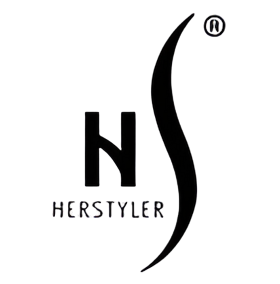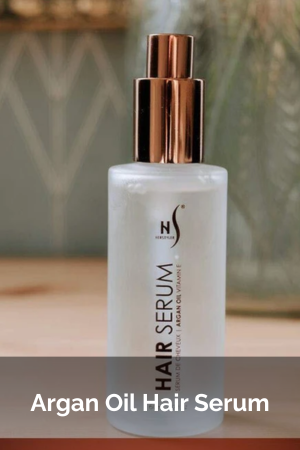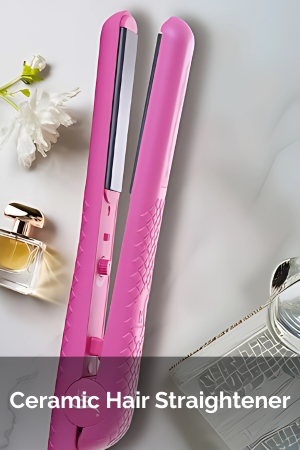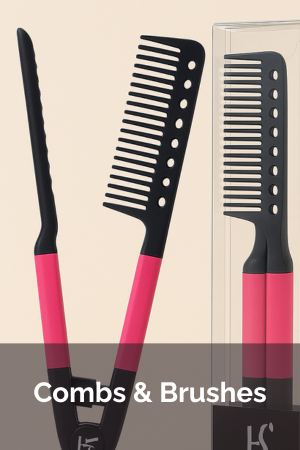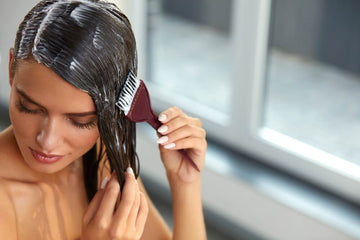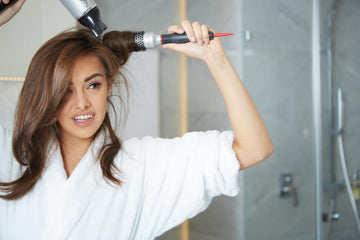Hair masks are often touted as being a holy grail hair care product. Adding one to your routine can really help to add some gloss and fullness to the look of your locks…so long as you use it correctly and at the right frequency. Getting this wrong may not seem like a big deal initially but, over time, you could end up unintentionally causing some serious damage to your strands.
So, today, HerStyler is going to explain how often a hair mask should be used, along with how to actually go about using one in the best way possible.
What Exactly is a Hair Mask & Why Should You Use One?
 To avoid any confusion, let’s start by making sure that we’re on the same page when it comes to what a hair mask is. Many people assume that they’re the same as a deep conditioner or even a leave-in conditioner, but this isn’t the case.
To avoid any confusion, let’s start by making sure that we’re on the same page when it comes to what a hair mask is. Many people assume that they’re the same as a deep conditioner or even a leave-in conditioner, but this isn’t the case.
Conditioners, no matter what form they may take, are all about conditioning the hair. They’ll add smoothness and shine while also helping to keep your hair feeling safe from environmental damage.
Many hair masks do this too, yet they also offer additional benefits. They usually contain nutrient-dense ingredients that work to strengthen and repair the look of the hair. This is why they’re often thicker in consistency than most conditioners and need to be left on the hair for longer in order to give those ingredients time to penetrate the hair shafts.
To make the comparison even easier to comprehend, think of conditioners like moisturizers for your face. Meanwhile, a hair mask would be the equivalent of a face mask, meaning that they’re used less frequently but are designed to provide intensified benefits.
Of course, just like with all hair care products, the many different hair masks out there won’t all be equal in efficiency. This makes it important to pick a high-quality formula if you plan on adding a hair mask to your routine.
Our top choice would be the HerStyler Argan Oil Hair Mask. With argan oil as its signature ingredient, this hair mask is more than capable of transforming the look of your hair. Argan oil is revered for how it has been proven to prevent and reduce the appearance of oxidative damage. It also leaves the hair feeling thicker, stronger, and more elastic, meaning that you’ll be able to do away with strands that look brittle and weak.
How Often to Use a Hair Mask
 Now onto the big question; how often should you be using a hair mask?
Now onto the big question; how often should you be using a hair mask?
Unfortunately, there isn’t a simple single answer to this question. Sure, the instructions that come with your hair mask may advise on how often to use the product. However, ultimately, these are just guidelines. Instead, when deciding how often to apply a mask to your locks, you need to take your hair type and texture into account:
If You Have Dry, Curly, or Coily Hair…
If your hair is dry, then this means that you’ll really benefit from the moisture boost that a hair mask can provide. The same applies to those with a curly or coily hair type. Due to the curls or coils that you sport, it takes a while for the sebum produced by your scalp to work its way down your hair shaft. This means that, even if the top half of your hair isn’t dry, the ends are probably much thirstier.
So, to start with, use a hair mask twice a week. This will likely be after every shampoo since dry hair doesn’t usually need to be washed more than twice a week anyway. Overwashing dry hair will only leave your strands even drier.
After regularly using a hair mask for a few months, you may start to notice some improvements in how dry your hair feels. At this stage, if your hair no longer feels quite as dry, you can cut back your hair mask usage to once a week.
If You Have Fine, Thin, or Oily Hair…
Although other hair types can experience oiliness too, this tends to be an issue most prevalent in those with fine, thin, and straight hair. This is due to how the sebum produced by the scalp has an easy path down your hair shafts, without any curls or coils slowing its progress.
Over-using certain hair care products commonly leads to oily strands feeling even greasier. As a result, you need to be careful with your hair mask usage, saving it for just once a week. Even then, make sure that you concentrate the product on the ends of your hair. If it ends up on your roots, it’ll only leave your strands looking limp and heavy.
If you have oily hair, you’ll also need to be more choosy about the mask that you use. The majority of the hair masks out there are designed for dry or damaged hair. These will be too heavy for your thin and oily locks, so pick a product that has been formulated for your hair type.
If You Have Damaged or Brittle Hair…
If your hair feels brittle or looks damaged, then adding a hair mask to your hair care routine would be a wise move. The more damaged your hair is, the more this will benefit you.
Ideally, you should be using a hair mask two to three times a week. Again, this will probably be after every shampoo. This means that you could use a hair mask instead of your regular conditioner.
However, once your hair starts to look and feel stronger and healthier, you should then start to reduce how frequently you use a mask.
If You Have Normal, Healthy Hair…
If your hair feels completely healthy and normal, and you don’t have any of the oily/dry/damaged issues that we’ve discussed above, then you’re one of the lucky few! A hair mask can still be beneficial when it comes to giving your hair a boost of moisture and nutrients but, with your hair already being on the healthy side, it’s not going to need this quite as much as other hair types.
So, save your hair mask for weekly use, or even fortnightly applications. Don’t be tempted to overdo your hair mask usage as this could potentially end up damaging your beautifully healthy strands.
What Happens If You Use a Hair Mask Too Often?
 As mentioned, overusing a hair mask can be problematic, yet this is a mistake that many people make. It’s easy to understand why. After all, if a hair mask is designed to moisturize, strengthen, and repair the look of your hair, then surely using one more frequently will bring you results much sooner?
As mentioned, overusing a hair mask can be problematic, yet this is a mistake that many people make. It’s easy to understand why. After all, if a hair mask is designed to moisturize, strengthen, and repair the look of your hair, then surely using one more frequently will bring you results much sooner?
Unfortunately, this isn’t the case. Instead, when it comes to absorbing moisture and other nutrients, your hair has its limits. There is only so much that it can soak up. Pushing it past its saturation point could lead to a condition known as hydral fatigue. This is when the hair is exposed to excessive moisture, causing it to repeatedly swell and contract. Over time, this weakens the hair, leading it to look frizzy, dull, limp, and lifeless.
This is the opposite of what a hair mask should be doing. This makes it so important to use your mask at the correct frequency if you’re hoping to experience its full range of benefits.
How to Use a Hair Mask
Not only is it important to make sure that you aren’t over-using a hair mask, but you should also pay attention to how you actually apply it. Again, the method that you choose can be hugely influential on how well your mask works.
For best results, you should always apply a hair mask to clean hair. This will prevent dirt, oil, and other impurities from interfering with your mask’s ability to penetrate your strands. So, give your hair a wash with your favorite shampoo before getting started. Then, gently squeeze out excess moisture from your locks.
At this point, instead of applying your conditioner, reach for your hair mask. Start with a small, coin-sized amount, focusing the product on the mid-lengths and ends of your hair. Spend about 30 seconds smoothing this into your strands in downward motions. You may find it helpful to use a wide-toothed comb at this stage. This will make it easier to evenly disperse the product through your mane.
Then, give your mask time to soak into your strands. How long you leave it on will depend on the mask that you’re using. Hopefully, your mask’s packaging should display those guidelines. If not, 3-8 minutes tends to be the average. Don’t be tempted to leave it on for longer – this will only lead to the hydral fatigue we mentioned earlier.
Once you’re done, it’s time to rinse your mask off. Do this thoroughly to ensure that you haven’t left any remnants on your hair. If you have, this will only cause a heavy buildup that will weigh down and potentially damage your strands.
What About Leaving a Hair Mask on Overnight?
If your hair is severely dry or damaged, then you might be wondering if you could potentially leave your hair mask on overnight. You’ve probably seen photos of people doing this, wrapping their hair up before bed to prevent their hair mask from smearing over their pillows.
When it comes down to it, overnight masks can be very beneficial. However, you need to use a dedicated overnight mask, rather than a regular hair mask, for this. There are special formulas out there that have been designed specifically to be safely left on the hair for an extended period of time. If your hair mask doesn’t say anything about overnight use, then don’t use it in this way.
Summary
When it comes down to it, a hair mask can really be transformational in terms of how healthy your hair looks and feels. So long as you use it correctly, a hair mask is a fantastic tool for tackling the visible hair concerns that you’re dealing with while also balancing out the unique needs of your hair type. Pick a mask designed for your hair’s texture and issues, use it at a suitable frequency and in the right way, and you’ll soon be left with a head of hair that looks thicker, glossier, and healthier than ever.
Click here to explore more of HerStyler’s bestselling hair care and styling products.

